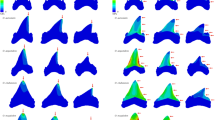Summary
A combination of simple membrane theory and statical analysis has been used to determine how stresses are carried in echinoid skeletons. Sutures oriented circumferentially are subject principally to compression. Those forming radial zig-zags are subject to compression near the apex and tension near the ambitus. Radial and circumferential sutures in Eucidaris are equally bound with collagen fibers but in Diadema, Tripneustes, Psammechinus, Arbacia and other regular echinoids, most radial sutures are more heavily bound, and thus stronger in tension. Psammechinus, Tripneustes and several other echinoids have radial sutures thickened by ribs which increase the area of interlocking trabeculae. Ribs also increase flexural stiffness and carry a greater proportion of the stress. Further, ribs effectively draw stress from weaker areas pierced by podial pores, and increase the total load which can be sustained.
Allometry indicates that regular echinoids become relatively higher at the apex as size increases, thus reducing ambital stresses. Some spatangoids with very high domes (eg Agassizia) maintain isometry, but others (eg Meoma) become flatter with size. Both holectypoids (Echinoneus) and cassiduloids (Apatopygus) maintain a constant height to diameter relationship. Flattening, and consequently ambital tensile stress, is greatest in the clypeasteroids. In this group the formation of internal buttresses which preferentially carry stress, reaches maximum development. A notable exception, however, is the high domed Clypeaster rosaceus.
In this analysis it was assumed that local buckling or bending does not occur. The test of some echinoids (e.g. Diadematoida) have relatively wide sutures swathed in collagen, which allows local deformation. Others (e.g. Arbacia) have rigid sutures with reduced collagen. In Psammechinus and other members of the Order Echinoida, in addition to rib formation, inner and outer surface trabeculae are thickened so that the individual plates are stiffened. Some spatangoids (Meoma, Paleopneustes) have extensive sutural collagen, but the cassiduloid Apatopygus has collagen confined to junctions of sutures, and elsewhere the joints are strengthened and stiffened by fusion of trabeculae. Fusion of surface trabeculae is almost complete in the holectypoid, Echinoneus, and the sutures are obscured.
Similar content being viewed by others
References
Burkhardt A, Hansmann W, Markel K, Niemann H-J (1983) Mechanical design in spines of diadematoid echinoids (Echinodermata, Echinoidea). Zoomorphology 102:189–203
Currey JD (1975) A comparison of the strength of echinoderm spines and mollusc shells. J Mar Biol Assoc UK 55:419–424
Dafni J (1984) Test growth and calcification of the regular echinoid Tripneustes gratilla elatensis. International Echinoderms Conference, Galway.
Emlet RB (1982) Echinoderm calcite: a mechanical analysis from larval spicules. Biol Bull 163:264–275
Eylers JP (1976) Aspects of skeletal mechanics of the starfish Asterias forbesii. J Morphol 149:353–367
Gordon JE (1968) The new science of strong materials. Penguin Books, Harmondsworth, England, pp 269
Gordon JE (1978) Structures: or why things don't fall down. Penguin Books, Harmondsworth, England, pp 395
Harold AS (1985) Body wall structure of Echinarachnius parma (Echinoidea: Clypeasteroida). M.Sc. Thesis, Department of Zology, University of Toronto
Heyman J (1977) Equilibrium of shell structures. Oxford University Press, England, pp 137
Hyman LH (1955) The Invertebrates. IV: Echinodermata. McGraw-Hill, New York, pp 763
Kenner H (1976) Geodesic math and how to use it. University of California Press Berkeley, Los Angeles, pp 172
Klein L, Currey JD (1970) Echinoid skeleton: absence of collagenous matrix. Science 169:1209–1210
Lin TY, Stotesbury SD (1981) Structural concepts and systems for architects and engineers. John Wiley and Sons, New York, pp 590
Moss ML, Meehan MM (1967) Sutural connective tissues in the test of an echinoid Arbacia puntulata. Acta Anat 66:279–304
Nichols D, Currey JD (1968) The secretion, structure, and strength of echinoderm calcite (pp 251–261). In: Cell structure and its interpretation. SM McGee-Russell and KFA Ross, Eds., Edward Arnold Ltd., London, pp 433
Mukhin NV, Pershin AN, Shishman BA (1983) Statics of structures. MIR publishers, Moscow, pp 405
O'Neill PL (1981) Polycrystalline echinoderm calcite and its fracture mechanics. Science 2133:646–648
Phelan TH (1977) Comments on the water vascular system, food grooves, and ancestry of the clypeasteroid echinoids. Bull Mar Sci 27:400–422
Raup DM (1962) The phylogeny of calcite crystallography in echinoids. J Paleontol 36:793–810
Seilacher A (1979) Constructional morphology of sand dollars. Paleobiology 5:191–221
Smith AB (1980) Stereom microstructure of the echinoid test. Spec Pap Palaeontol 25:1–81
Smith AB (1984) Echinoid palaeobiology. George Allen and Unwin, London, pp 190
Sokal RR, Rohlf FJ (1981) Biometry. WH Freeman and Co., San Francisco, pp 859
Strathmann RR (1981) The role of spines in preventing structural damage to echinoid tests. Paleobiology 7:400–406
Telford M (1985) Structural analysis of the test of Echinocyamus pusillus. Proc Int Echinoderms Conf, Galway 1984
Thadani BN (1964) Modern methods in structural mechanics. Asia Publishing House, Bombay, pp 619
Travis DF (1970) The comparative ultrastructure and organization of five calcified tissues. In: Biological calcification. H Schraer ed. Appleton-Century-Crofts, New York, pp 203–311
Ugural AC (1981) Stress in plates and shells. McGraw Hill Book Co., NY, pp 317
Wainwright SA, Biggs WS, Currey JD, Gosline JM (1976) Mechanical design in organisms. Edward Arnold, England, pp 423
Weber J, Greer R, Voight B, White E, Roy R (1962) Unusual strength properties of echinoderm calcite related to structure. J Ultrastructure Res 26:355–366
Author information
Authors and Affiliations
Rights and permissions
About this article
Cite this article
Telford, M. Domes, arches and urchins: The skeletal architecture of echinoids (Echinodermata). Zoomorphology 105, 114–124 (1985). https://doi.org/10.1007/BF00312146
Received:
Issue Date:
DOI: https://doi.org/10.1007/BF00312146




